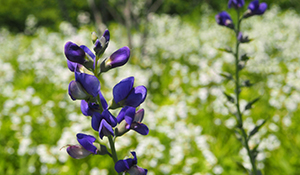The Importance of Native vs. Non-Native Plants
Posted July 8, 2022

Summertime brings an array of blooms to Chester County — from colorful trees and shrubs to fragrant flowers and veggies. While some of these plants are native to the area (meaning they grow naturally), others have been planted for a specific purpose (aesthetics, culinary, etc.), and some are transferred by birds and other accidental methods.
Although non-native plants can sometimes seem more appealing due to their look and convenience, native plants are a much better option as they promote a sustainable landscape and play a critical role in protecting the county against the spread of invasive plants.
Additionally, native plants help to protect local wildlife habitats, increase water quality, reduce maintenance needs and costs, increase property values, lessen the use of harmful pesticides, and provide beautiful seasonal foliage since they occur naturally in an area and are well adapted to the region's soils and climate.
One major problem with some non-native plants is their invasive growth patterns and ability to reproduce rapidly, which can result in harm to the environment, economy, and even human health. The Japanese Honeysuckle for instance — commonly seen along roadsides, fences, and throughout fields across southern PA — is an invasive, non-native vine that will climb over and suffocate desirable native plants. See the Department of Conservation & Natural Resources' Fact Sheet for more info on invasive plants.
The Pennsylvania Municipalities Planning Code empowers Chester County municipalities to enact ordinances that promote safety, health, and general welfare. As such, requirements for the use of native plant species in new developments and the control of invasive species can be incorporated into municipal ordinance language.
An example can be seen in Schuylkill Township's Subdivision and Land Development Ordinance, which includes an extensive list of native trees, shrubs, perennials, and water-adapted plants. The list also includes the sun and moisture requirements of each plant.
Learn more about native plants in Chester County.
CCPC's planning eTools are intended to be user-friendly, providing a quick overview of each topic, an explanation of how it works, and considerations for addressing the topic within a community. Topic categories include agriculture; community health; economic development; environment; historic preservation; housing; land use; open space; transportation; utilities, infrastructure & energy. View the full list of eTools.

